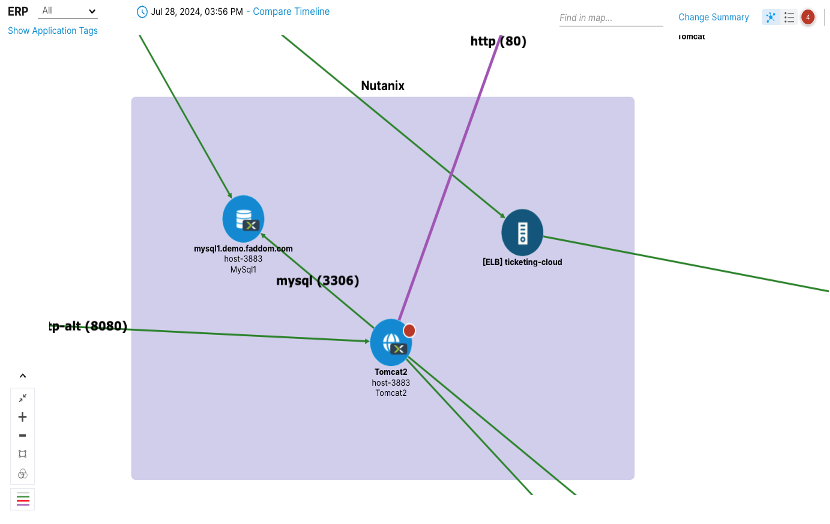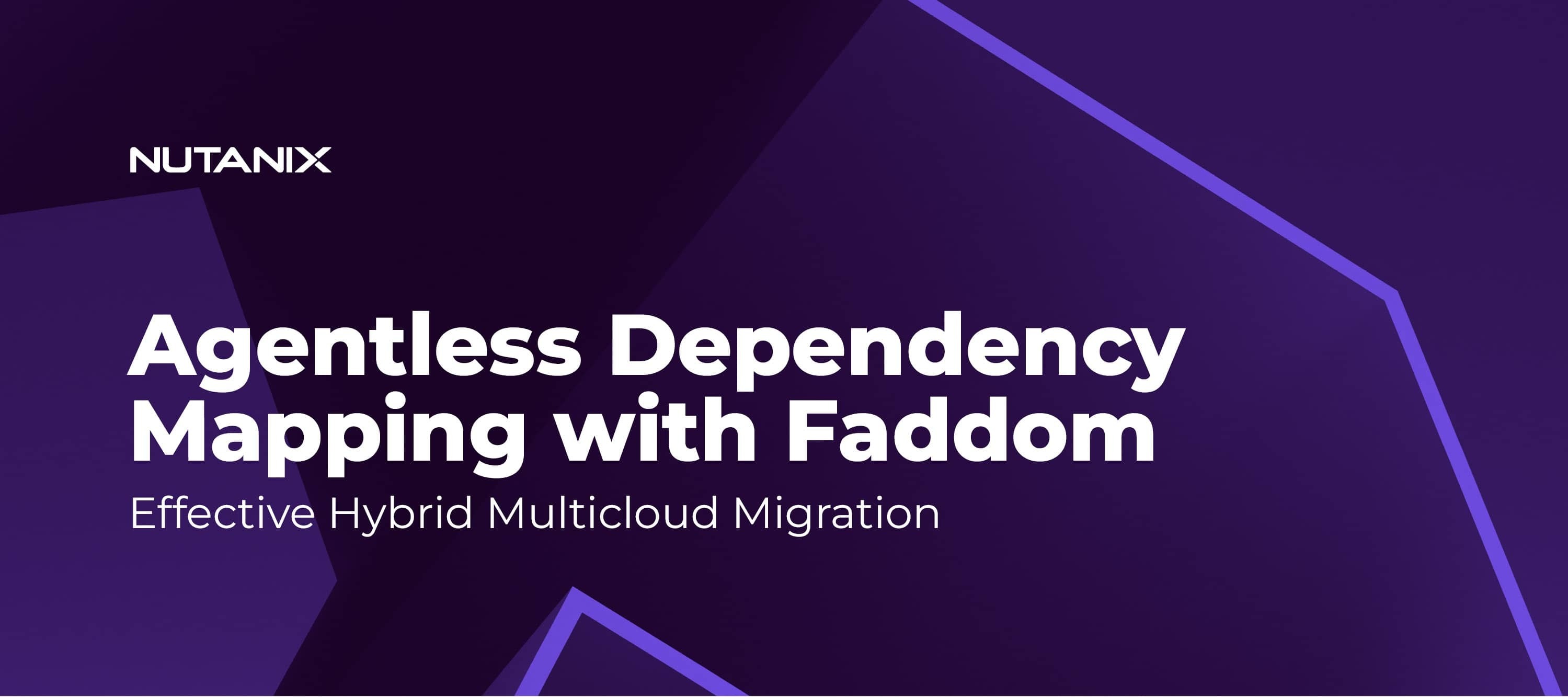Understanding and mapping the relationships between business-critical hybrid multicloud infrastructure and applications is a fundamental best practice for security, monitoring and documentation. The stakes are even higher when preparing for a major migration like a move to the Nutanix Cloud Platform.
Many organizations generate robust application dependency maps at one time. Over time, however, integrations pile up, org charts become outdated and documentation becomes increasingly divorced from reality. When planning for a migration, it can be difficult to pin down dependencies, understand which systems or applications can be left behind and ensure a smooth rollback in case of potential issues. Facing urgent migration timelines, IT teams must often shoulder the responsibility of finding a quality solution, fast.
This blog explores how Faddom, a Nutanix Technology Alliance Partner, meets these challenges head-on. Faddom’s automated dependency mapping solution helps plan for a new environment primed to meet all business requirements. This ensures nothing is left behind and dramatically accelerates migration planning and execution while mitigating risk and improving security.
Reducing Risk by Pinpointing Application-Infrastructure Dependencies
With recent changes in the virtualization market, many organizations face greater pressure to execute migrations to new hypervisors or hybrid multicloud environments. By switching to Nutanix, organizations can drive new value through easy scalability, simplified single-pane resource management and flexible support for diverse workloads, including virtualized applications, databases and containers. But to unlock this value, organizations must execute the migration process without sacrificing operational stability, security, or meticulous documentation.
A thorough server discovery and business applications assessment process provides a foundation for a successful migration. Pinpointing the precise relationships between all applications, databases and servers is a fundamental step in every phase of the migration:
- Specify optimal performance, scalability and capacity requirements for the target Nutanix environment and design an appropriate architecture.
- Configure, deploy and install the new Nutanix environment.
- Final testing and post-deployment monitoring.
- Decommission.
- Documentation.
A comprehensive approach to dependency mapping is the most efficient and effective way to move forward while making sure no critical business functionality is left behind and a rapid, clean rollback can occur if necessary.
But when migrating to a complex enterprise environment with dozens or hundreds of application dependencies, this assessment can constitute a substantial IT management challenge – an overlooked detail or dependency blind spot can derail an otherwise successful project.
Pre-emptive, Strategically Prioritized Planning Drives Smoother Migrations
An effective migration process should anticipate complexity in the planning phase and set aside time and resources accordingly. A prototypical migration planning effort can be around four times more time-consuming than the migration process itself. Nonetheless, this upfront investment is well worth it to secure a smooth, timely migration process and avoid the risk of a costly rollback or unplanned system downtime.
The migration planning process needs to:
- Include a comprehensive picture of application and infrastructure dependencies.
- Support strategic prioritization of migration components.
- Clearly articulate potential risks to IT operations and outline mitigation strategies prior to migration.
- Analyze downtime and other impacts to the business.
This multifaceted analysis can be time-consuming and resource-intensive under any circumstances, but it becomes far more difficult when organizations are faced with urgent timelines, migrating legacy systems with sparse documentation or planning for systems with poorly monitored utilization.
This is where Faddom can help.
Faddom Drives Proactive Dependency Discovery
Through real-time, agentless application dependency mapping (ADM), Faddom dramatically accelerates the migration planning process by generating a comprehensive map of servers, business applications, VMs, network connections, and their many interdependencies.
“Once you map the infrastructure with Faddom, you understand the dependencies, so you can be proactive, plan ahead and approach the project strategically. It’s not just as a lift-and-shift.”
Itamar Rotem, Chief Product Officer at Faddom
Faddom provides fully visualized dependency maps for on-premise and cloud infrastructure within minutes comprehensive premigration visibility makes it easy to keep documentation up-to-date. A true engine for automated migration planning, Faddom directly enables an optimal migration to Nutanix by informing a strategy that proactively side-steps the pitfalls that come with a lift-and-shift migration.

Faddom’s solution is tailored to:
- Improve hybrid network visibility with continuous, dynamic hybrid mapping.
- Generate accurate topology documentation to facilitate migration planning and support robust change management practices.
- Maintain comprehensive information for IT audits and compliance reviews.
- Unlock new efficiencies by identifying redundant and unnecessary servers or instances.
These capabilities provide a versatile toolkit that can accelerate time-to-value for migrations while minimizing downtime and laying the groundwork for long-term operational success. With the ability to support firewall configuration planning and automatically detect potential vulnerabilities, Faddom can even help secure the new hybrid multicloud environment.
“I’m still working on untangling all sorts of stuff that’s multi-years old,” reports the infrastructure manager for one Faddom customer, “and there is no documentation. The use of Faddom is invaluable to us in that respect – for documentation and to ensure no one is adding servers that we don’t know about.”
Post-Migration Management Made Easy with Nutanix
After the migration, the Nutanix Cloud Platform provides robust capabilities for managing hybrid multicloud infrastructure, with Faddom continuing to support a heightened long-term network visibility posture.
- Nutanix Prism, a unified hybrid multicloud management solution, streamlines monitoring and administration of Nutanix clusters from a single pane of glass.
- Nutanix AOS provides an integrated hardware-agnostic operating system with the built-in Nutanix AHV hypervisor.
- Prism Central provides for the easy deployment of new virtualization clusters, while Prism Element allows for the easy management of Nutanix clusters running any hypervisor.
Learn More About Nutanix with Faddom
For a more in-depth examination of how Faddom works with Nutanix to streamline IT operations, download our solution brief.
Itamar Rotem, Chief Product Officer at Faddom, lays out the company’s vision for complementing Nutanix capabilities and streamlined management features in this interview at .NEXT 2024:
Please reach out to your account manager if you are interested in learning more about how Nutanix works with Faddom.
Interested in seeing Faddom up close? Book a demo here.
©2024 Nutanix, Inc. All rights reserved. Nutanix, the Nutanix logo and all Nutanix product, feature and service names mentioned herein are registered trademarks or trademarks of Nutanix, Inc. in the United States and other countries. Other brand names mentioned herein are for identification purposes only and may be the trademarks of their respective holder(s). This post may contain links to external websites that are not part of Nutanix.com. Nutanix does not control these sites and disclaims all responsibility for the content or accuracy of any external site. Our decision to link to an external site should not be considered an endorsement of any content on such a site. Certain information contained in this post may relate to or be based on studies, publications, surveys and other data obtained from third-party sources and our own internal estimates and research. While we believe these third-party studies, publications, surveys and other data are reliable as of the date of this post, they have not independently verified, and we make no representation as to the adequacy, fairness, accuracy, or completeness of any information obtained from third-party sources.
This post contains express and implied forward-looking statements, including but not limited to statements regarding our plans and expectations relating to new product features and technology that are under development, the capabilities of such product features and technology and our plans to release product features and technology in the future. Such statements are not historical facts and are instead based on our current expectations, estimates and beliefs. The accuracy of such statements involves risks and uncertainties and depends upon future events, including those that may be beyond our control, and actual results may differ materially and adversely from those anticipated or implied by such statements. Any forward-looking statements included herein speak only as of the date hereof and, except as required by law, we assume no obligation to update or otherwise revise any of such forward-looking statements to reflect subsequent events or circumstances. Any future product or product feature information is intended to outline general product directions, and is not a commitment, promise or legal obligation for Nutanix to deliver any functionality. This information should not be used when making a purchasing decision


